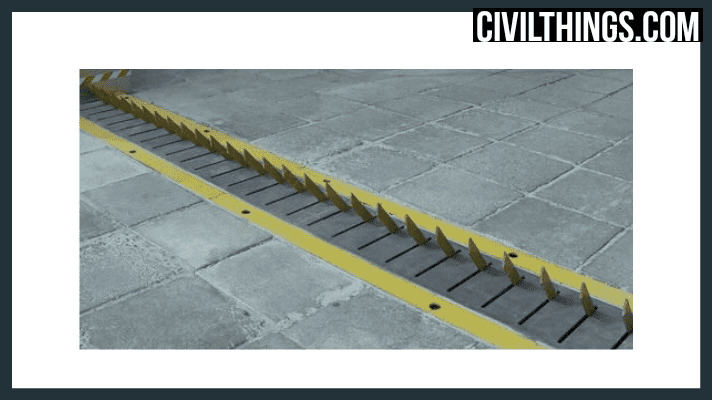Some Known Details About Wedge Barriers


18 may be done faster, conveniently, and cost successfully. FIG. In specific embodiments, the support 30 might be a steel structure consisting of plates, beams(e. g., I-beams ), and/or other structures that are protected within the foundation 14, which may be concrete. At the surface area 12, a top side 28 of the support 30 may go to the very least partly revealed
, therefore enabling the accessory of the obstacle 10 to the support 30. g., threaded openings)in one or even more beams or plates of the support 30 may be exposed to the surface area 12. In this fashion, screws 32 or other mechanical fasteners might be made use of to secure the barrier 10 to the support 30. As the obstacle 10 is placed to the surface 12 of the foundation 14, collection of debris and other product beneath the barrier may be decreased, and components of the bather 10 may not be subjected to below quality environments. As indicated by recommendation numeral 52, the training mechanism 50 includes components got rid of beneath the wedge plate 16. The components 52 below the wedge plate 16 might consist of an electromechanical actuator, a camera, one or even more camera surface areas, and so forth. Furthermore, the training system 50 includes a springtime setting up 54
The spring rod 58 is coupled to a web cam(e. g., camera 80 displayed in FIG. 4) of the lifting system 50. The springtimes 60 disposed regarding the spring pole 58 are kept in compression by springtime sustains 62, consisting of a dealt with springtime assistance 64. That is, the fixed springtime support 64 is dealt with loved one to the foundation 14 and the rest of the bather 10.
Wedge Barriers Can Be Fun For Anyone
g., springtime assistance 65 )may be dealt with to the end of the springtime rod 58 to allow compression of the springtimes 60. As the springtimes 60 are compressed between the springtime sustains 62, the springtime assembly 54 generates a pressure acting upon the cam paired to the springtime pole 58 in a direction 66. The continuing to be pressure applied to
the cam web cam deploy check my site release wedge plate 16 may be provided by an electromechanical actuator 84 or other actuator. Thus, the springtime assembly 54 and the actuator 84(e. g., electromechanical actuator)might operate with each other to convert the web cam and lift the wedge plate 16.
As pointed out above, the springtime assembly 54 puts in a constant force on the cam, while the electromechanical actuator may be managed to exert a variable pressure on the camera, consequently enabling the training and lowering( i. e., deploying and retracting )of the wedge plate 16. In particular personifications, the continuous pressure used by the springtime assembly 54 may be flexible. g., electromechanical actuator) is impaired. As will certainly be valued, the springtime assembly 54 might be covered and protected from particles or other components by a cover plate(e. g., cover plate 68 displayed in FIG. 4) that may be substantially flush with the raised surface 38 of the foundation 14. As discussed over, in the released placement, the wedge plate 16 offers to obstruct access or travel beyond the obstacle 10. As an example, the obstacle 10(e. g., the wedge plate 16 )may block pedestrians or automobiles from accessing a home or path. As talked about above, the barrier 10 is attached to the anchor 30 protected within the foundation 14,

front braces 71. Because of this, the affiliation settings up 72 may pivot and turn to make it possible for the collapse and expansion of the linkage settings up 72 throughout retraction and implementation of the bather 10. The link assemblies 72 cause activity of the wedge plate 16 to be limited. For instance, if a vehicle is traveling towards the released wedge plate 16(e. For instance, in one condition, the safety legs 86 may be extended duringupkeep of the obstacle 10. When the safety legs 86 are released, the safety legs 86 sustain the weight of the wedge plate 16 versus the surface area 12. Because of this, the training system 50 may be shut down, serviced, eliminated, changed, and so forth. FIG. 5 is partial perspective view of an embodiment of the surface-mounted wedge-style obstacle 10, illustrating the webcam 80 and the cam surfaces 82 of the lifting device 50. Especially, two webcam surface areas 82, which are referred to as lower cam surface areas 83, are placed below the webcam 80. The lower webcam surface areas 83 may be repaired to the surface area 12 (e. For instance, the reduced webcam surface areas 83 and the installing plate 85 may form a single piece that is protected to the support 30 by bolts or other mechanical bolts. Additionally, 2 cam surface areas 82, which are described as upper web cam surfaces 87, are positioned over the camera 80 and combined to (e. In why not check here other personifications, intervening layers or plates might be placed in between the surface area 12 and the lower cam surface areas 83 and/or the wedge plate 16 and the their website top camera surface areas 87 As pointed out over, the webcam
80 equates along the cam surfaces 82 when the wedge plate 16 is raised from the pulled back setting to the deployed position. Furthermore, as pointed out over, the spring setting up 54 (see FIG. 3 )may offer a force acting on the web cam 80 in the direction 102 via springtime pole 58, which might lower the force the electromechanical actuator 84 is called for to put on the web cam 80 in order to actuate and raise the wedge plate 16. 1 )to the deployed position(see FIG. 4). As shown, the webcam 80 consists of track wheels 104(e. g., rollers), which contact and convert along the web cam surfaces 82 throughout operation.